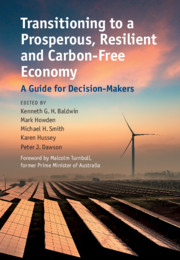Book contents
- Transitioning to a Prosperous, Resilient and Carbon-Free Economy
- Transitioning to a Prosperous, Resilient and Carbon-Free Economy
- Copyright page
- Dedication
- Contents
- Figures
- Tables
- Contributors
- Foreword
- Introduction
- 1 Policy Frameworks and Institutions for Decarbonisation: The Energy Sector as ‘Litmus Test’
- Technologies for Decarbonising the Electricity Sector
- Example Economies
- Cities and Industry
- 11 Cities
- 12 Buildings and Precincts
- 13 Urban Water
- 14 National Climate Change Adaptation Case Study: Early Adaptation to Climate Change through Climate-Compatible Development and Adaptation Pathways
- 15 Transport
- 16 Industry and Manufacturing
- Land Use, Forests and Agriculture
- Mining, Metals, Oil and Gas
- Addressing Barriers io Change
- Index
- References
14 - National Climate Change Adaptation Case Study: Early Adaptation to Climate Change through Climate-Compatible Development and Adaptation Pathways
from Cities and Industry
Published online by Cambridge University Press: 08 October 2021
- Transitioning to a Prosperous, Resilient and Carbon-Free Economy
- Transitioning to a Prosperous, Resilient and Carbon-Free Economy
- Copyright page
- Dedication
- Contents
- Figures
- Tables
- Contributors
- Foreword
- Introduction
- 1 Policy Frameworks and Institutions for Decarbonisation: The Energy Sector as ‘Litmus Test’
- Technologies for Decarbonising the Electricity Sector
- Example Economies
- Cities and Industry
- 11 Cities
- 12 Buildings and Precincts
- 13 Urban Water
- 14 National Climate Change Adaptation Case Study: Early Adaptation to Climate Change through Climate-Compatible Development and Adaptation Pathways
- 15 Transport
- 16 Industry and Manufacturing
- Land Use, Forests and Agriculture
- Mining, Metals, Oil and Gas
- Addressing Barriers io Change
- Index
- References
Summary
This chapter describes four case studies – three from Australia and one from rural Indonesia – that build the argument that to enhance the potential for multiple benefits, climate adaptation needs to be integrated into development and planning processes. The case studies demonstrate (1) the early benefits from adaptation to coastal inundation, (2) the importance of considering the distribution of costs and benefits across communities, (3) the low-regrets nature of some early adaptation actions and (4) the synergies between adaptation measures and sustainable development. By demonstrating the multiple benefits of climate adaptation, case studies like these have stimulated thinking about climate adaptation in terms of adaptation pathways and climate-compatible development. Early adaptation creates resilience by maintaining diversity, flexibility and adaptability – factors that enable people to benefit from future opportunities. Adaptation pathways approaches help stakeholders better understand how adaptation can address the systemic drivers of vulnerability and how to integrate adaptation into broader planning approaches.
Keywords
- Type
- Chapter
- Information
- Transitioning to a Prosperous, Resilient and Carbon-Free EconomyA Guide for Decision-Makers, pp. 365 - 388Publisher: Cambridge University PressPrint publication year: 2021
References
- 1
- Cited by



